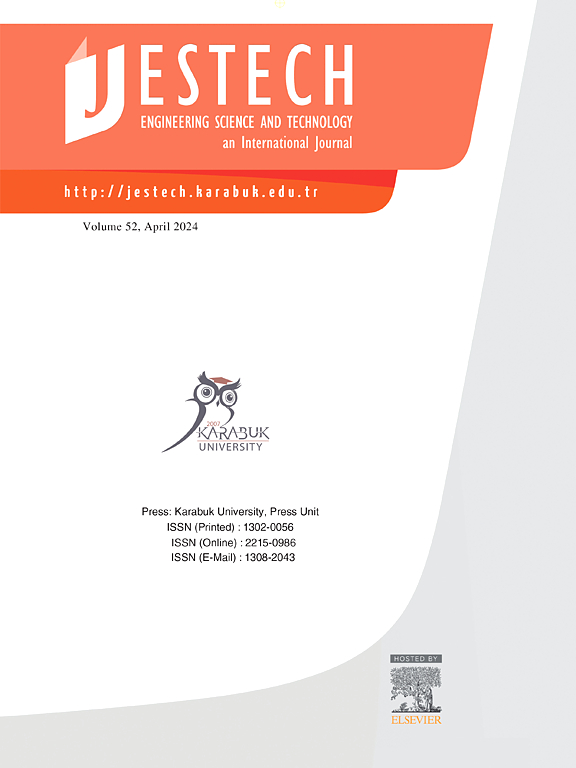单/多颗粒磨削参数对轴承钢 GCr15 表面特性的影响
IF 5.1
2区 工程技术
Q1 ENGINEERING, MULTIDISCIPLINARY
Engineering Science and Technology-An International Journal-Jestech
Pub Date : 2024-10-01
DOI:10.1016/j.jestch.2024.101851
引用次数: 0
摘要
磨削表面残余应力(RS)对零件的使用寿命有重要影响。本研究建立了单颗粒磨削力(GF)和磨削温度(GT)的数学模型。通过数值模拟分析了磨削参数、磨削力-热耦合与单颗粒残余应力之间的关系。同时,针对航空精密高速轴承套圈的多晶粒磨削,对服役和非服役轴承套圈的晶体破碎、元素含量和残余应力进行了实验分析。在此基础上,得出以下结果:在模拟中,相同磨削力和磨削温度下,Y 方向的残余应力>;X 方向的残余应力>;Z 方向的残余应力>。在实验中,(1) 服役前轴承滚道的晶粒大小约为 24 μm,服役后轴承滚道的晶粒大小约为服役前的 3 倍。(2) 破碎后(使用后),C、Si、Cr 和 Fe 分别减少了 0.83 %、0.07 %、1.09 % 和 32.75 %。相反,O 和 Pr 分别增加了 0.66 % 和 34.08 %。Pr元素主要分布在破碎的晶界中。(3) 服役后,切向残余压应力减少了 169.3 兆帕,而轴向残余应力增加了 172.6 兆帕。本文章由计算机程序翻译,如有差异,请以英文原文为准。
Effect of single/multi-particle grinding parameters on surface properties of bearing steel GCr15
Grinding surface residual stress (RS) has an important influence on the service life of parts. In this study, the mathematical model of grinding force (GF) and grinding temperature (GT) of single particle was established. The relationship between grinding parameters, grinding force-thermal coupling and residual stress of single particle was analyzed by numerical simulation. Meanwhile, aiming at the multi-grain grinding of aviation precision high-speed bearing rings, the experimental analysis of crystal fragmentation, element content and residual stress of service and non-service bearing rings were carried out. Based on the above, the following results were obtained: in the simulation, the residual stress in the Y direction > the residual stress in the X direction > the residual stress in the Z direction at the same grinding force and grinding temperature. In the experiment, (1) The grain size of bearing raceway before service was about 24 μm, and the grain size of bearing raceway after service was about 3 times smaller than that before service. (2) C, Si, Cr and Fe decreased by 0.83 %, 0.07 %, 1.09 % and 32.75 % respectively after crushing (after service). On the contrary, it increased 0.66 % O and 34.08 % Pr. The Pr element was mainly distributed in the broken grain boundaries. (3) After service, the tangential residual compressive stress decreased by 169.3 MPa, while the axial residual stress increased by 172.6 MPa.
求助全文
通过发布文献求助,成功后即可免费获取论文全文。
去求助
来源期刊

Engineering Science and Technology-An International Journal-Jestech
Materials Science-Electronic, Optical and Magnetic Materials
CiteScore
11.20
自引率
3.50%
发文量
153
审稿时长
22 days
期刊介绍:
Engineering Science and Technology, an International Journal (JESTECH) (formerly Technology), a peer-reviewed quarterly engineering journal, publishes both theoretical and experimental high quality papers of permanent interest, not previously published in journals, in the field of engineering and applied science which aims to promote the theory and practice of technology and engineering. In addition to peer-reviewed original research papers, the Editorial Board welcomes original research reports, state-of-the-art reviews and communications in the broadly defined field of engineering science and technology.
The scope of JESTECH includes a wide spectrum of subjects including:
-Electrical/Electronics and Computer Engineering (Biomedical Engineering and Instrumentation; Coding, Cryptography, and Information Protection; Communications, Networks, Mobile Computing and Distributed Systems; Compilers and Operating Systems; Computer Architecture, Parallel Processing, and Dependability; Computer Vision and Robotics; Control Theory; Electromagnetic Waves, Microwave Techniques and Antennas; Embedded Systems; Integrated Circuits, VLSI Design, Testing, and CAD; Microelectromechanical Systems; Microelectronics, and Electronic Devices and Circuits; Power, Energy and Energy Conversion Systems; Signal, Image, and Speech Processing)
-Mechanical and Civil Engineering (Automotive Technologies; Biomechanics; Construction Materials; Design and Manufacturing; Dynamics and Control; Energy Generation, Utilization, Conversion, and Storage; Fluid Mechanics and Hydraulics; Heat and Mass Transfer; Micro-Nano Sciences; Renewable and Sustainable Energy Technologies; Robotics and Mechatronics; Solid Mechanics and Structure; Thermal Sciences)
-Metallurgical and Materials Engineering (Advanced Materials Science; Biomaterials; Ceramic and Inorgnanic Materials; Electronic-Magnetic Materials; Energy and Environment; Materials Characterizastion; Metallurgy; Polymers and Nanocomposites)
 求助内容:
求助内容: 应助结果提醒方式:
应助结果提醒方式:


